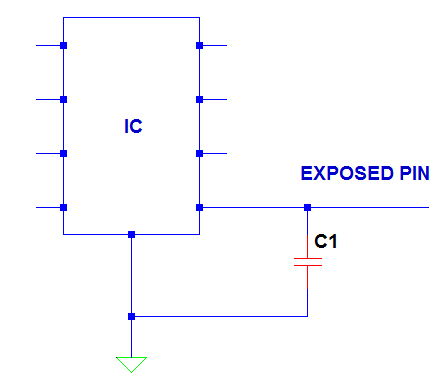Electrostatic discharge or simply ESD is a universal problem in electronic circuits. Capacitor as ESD protection is providing economical solution to the problem. I used to work in automotive electronics and we used high frequency capacitors to protect the exposed pins of our product. Exposed pins are the one accessible to users. There are several ways to protect devices from ESD but in this article I will be focusing to capacitor as ESD protection. For other techniques, you may read the article “Protecting Devices from ESD Damage”. Below is a typical circuit wherein a ceramic capacitor is installed in an IC that has exposed trace to protect against ESD.
Principle behind Capacitor as ESD Protection
The principle use in based on the conservation of charges. Capacitor is a passive electronic device that capable of storing charges on its plates. Think like this:
if you are walking on a carpeted floor, you have accumulated charges on your body since your body has capacitance. When you touch to the exposed pin, the charge on your body will discharge to the pin and the capacitor.
The ESD model is drawn like below. CESD is the body capacitance while VESD is the peak voltage associated by this capacitance. In one of our projects before, the CESD and VESD is specified by the customer to be 330pF and 8kV respectively.
So, when you are walking on a carpeted or rough surface the charge in your body is can be considered as the initial charge. From charge equation Q=CV, we can formulate below equation based from the above diagram.
When you touch the exposed pin, the charge in your body will transfer to the pin and the capacitor installed on it. The equivalent circuit is below
The final charge will be
Where Cfinal is the parallel combination of C1 and CESD and Vfinal is the equivalent voltage impressed on the pin. This is also the voltage that the capacitor C1 will experience.
By virtue of conservation of charges,
Expresssing Vfinal
Expressing C1
Example
CESD = 330pF, VESD = 8kV, compute for the value of a ceramic capacitor needed to install on the exposed IC pin that can withstand only a surge voltage of 200V.
Solution
It is not good to use 200V directly; instead we will consider a margin. As a rule of thumb, we can use only 60% of the 200V which is 120V. So,
So
The nearest standard value is 22nF. A 22nF C1 value will give a voltage on the pin of
Therefore use a 22nF ceramic capacitor with a voltage rating of 200V on the exposed pin of the IC.
Capacitor as ESD protection is proven effective for applications that do not require a very fast response. However for application that requires very fast response like short circuit detection, over voltage detection and the likes, a bigger value capacitor may be not suitable since this will introduce a significant delay to the pin signal.














I went through your article on ESD and it was very clear and crisp. Would it be possible for you to have an article on the comparison of different types of ESD protection techniques?. I feel it will add more value to the readers.
Thank you.
How is the value of Cesd calculated?
Cesd is the capacitance value of the human body model or whatsoever. It is a given value.
Very Nice crystal clear explanation